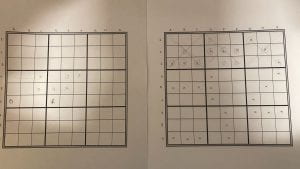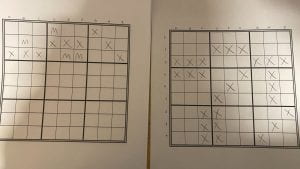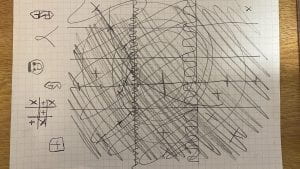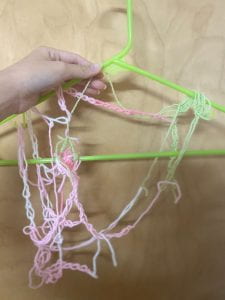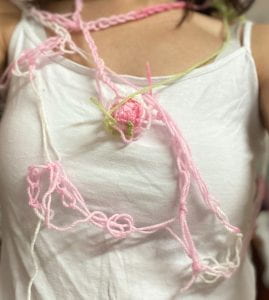Goal: Avoid becoming homeless and gain the most money in life. To become homeless, you have negative balance at any time
Instructions:
-
- Start with players at the start
- Player class is determined with a roll of a 6 sided die.
- Player with the highest roll = higher class
- Player with 2nd highest roll = middle class
- Everyone else = lower class
- Keep track of points (school points) and total college debt left
- Roll a D6 to get a number of steps taken around the board
- Landed on an Yellow Empty Space, draw an school action card before
- If you pass a Red Tax Space, pay up job tax (indicated on career card) + percentage of total college debt (if applicable) + life tax ($50)
- If you do not have a job, you have to only pay life tax
- If you pass Green Pay Day, you get paid!
- If you pass White Career Space, choose a job!
-
- University-required:
-
-
- Doctor
- School Point Requirement: greater than 20
- Pay: $1500
- College Debt: $300 x turns spent in college
- Tax: $300
- Nurse
- School Point Requirement: 17
- Pay: $1200
- College Debt: $200 x turns spent in college
- Tax: $300
- Engineer
- School Point Requirement:15
- Pay: $900
- College Debt: $150 x turns spent in college
- Tax: $100
- Secretary
- School Point Requirement: 10
- Pay: $700
- College Debt: $100 x turns spent in college
- Tax: $100
- News Anchor
- School Point Requirement: 5
- Pay: $600
- College Debt: $50 x turns spent in college
- Tax: $ 100
- Doctor
-
-
- University not required:
-
-
- Barista
- School Point Requirement: less than 0 (negative)
- Pay: $100
- College Debt: $0
- Tax: $50
- Cashier
- School Point Requirement: 0
- Pay: $150
- College Debt: $0
- Tax: $50
- Waiter
- School Point Requirement: 1
- Pay: $200
- College Debt: $0
- Tax: $50
- Barista
-
-
- Other:
-
-
- No job (Roll a NAT20 to choose a job)
- College vs Job:
- College:
- Higher class: Your family has been donating to the college for generations. You get in and your parents cover all your student debt. Earn 5 points for going to a well-known college.
- Middle class/Lower class: (needs minimum of 2 school points to go to college)
- 1-5: You studied and did well for the PSAT and SATs so you got in with a scholarship (- 75% of college debt)
- 6:You studied and did amazing on the PSAT and SATs so you got in with full scholarship (- 100% of college debt)
- 7-8: You got into college, but you’re not outstanding, not a lot of scholarships were offered (-25% college debt)
- College:
-
Action Cards
High School:
Failed test!
- Higher class: your parents donates to the school, they don’t care and gives you a pass after a quick call to the principal. You get a school point.
- Middle class: Parents paid for tutoring to catch up in class. Roll a D8.
- 3-8: you paid attention and passed the final, the actual exam that matters. Get a school point.
- 1-2: You didn’t pay attention and made the same mistakes on the exam. Lose a school point.
- Lower class: you tried to study, but trying to study without help is difficult. Roll a D20.
- 20: You passed the exam through a miracle! Earn a school point
- 1-19: You failed. Obviously. Lose a school point.
Great science project!
- Higher class: Your parents were so proud that they bragged to friends, family, and even colleagues. You made it to the town newspaper! Gain 3 school points.
- Middle class: Roll a D8.
- 3-8: The paper caught wind of you, so they decided to do coverage on you. You made the school look good. Gain 2 school points.
- 1-2: You got an A on the project, earning 1 school point.
- Lower class: you tried to study, but trying to study without help is difficult.
- You got an A on the project, earning 1 school point.
AP Class!
- Higher class: Your parents are able to afford the exam as well as the test prep books for you to study for the test, you aced it! Earn 5 school points
- Middle class: Your parents were able to afford the $100 fee but you weren’t able to get all the prep books that you’d hoped for. You passed. Earn 3 points.
- Lower class: Your parents aren’t able to afford the exam, so you decided to not take the class.
College:
Cheating Accusations
- Higher class: Your family has been donating to the college for 5 generations. The college apologizes for accusing you of such things. Gain 5 school points as compensation.
- Middle/Lower class: Roll a D8.
- 1-3: You nearly forgot to show up to the board meeting. Thus, you didn’t prepare for it and were accused of cheating. Lose a point.
- 4-8: You prepared and showed up with receipts that you did not cheat and have done the work all on your own without copying. College apologizes for doubting you. Gain 3 points
Extra Credit Essay
- Higher class: You pay an outside source to write your essay, allowing you to ace the class and bringing up your GPA even more. Gain 5 school points
- Middle class: Roll D8
- 1-2: You have help from in-class resources to compose an outstanding essay. Gain 3 school points
- 3-8: You did it to the best of your abilities but you didn’t have a full understanding of the course. You earned 1 school point
- Lower class: Roll a D20.
- 1-19: You decide to not do the essay.
- 20: You aced the extra credit, allowing you for more points in the class but it’s not great. Gain 1 school point
Internet Issue on Deadline
- Higher class: No way, your parents paid for the top-of-the-line internet, it never crashes. Gain 3 school points.
- Middle class: You have a hotspot and just made the deadline, but didn’t have time to add finishing touches to your assignment. Gain 2 points.
- Lower class: **** it you fail the assignment. Lose 3 points.
Career:
Car Accident
- Higher class: You got other cars, you’d be fine. You have connections to a great lawyer so you don’t have to pay for damages either!
- Middle class: You have good insurance, but there are still some fees that you have to pay. Lose $100.
- Lower class: You can’t afford to fix your car, so you have to use a bike to get to work until you have enough money to fix it. This makes you late to work, causing you to get paid less. Lose $100 from paycheck during Pay Day. You have to pay a fee from your sketchy insurance. Lose $150.
Hurricane!
- Higher class: You have an underground, mansion–sized bunker with immaculate insurance on your house. You got all the damages repaired for a great price while living in luxury. Lose $100
- Middle class: You have decent insurance, but some damaged items were not covered. You have to replace them out of pocket. Lose $500.
- Lower class: Your insurance is ****, they’re not replacing anything. Why do you even pay them? Lose $1500 to replace all your furniture and house.
Robbed
- Higher class: You had CCTV cameras in the neighborhood and were able to capture the robber’s face from multiple angles. The police made the arrest and all your stolen assets were returned to you.
- Middle class: Roll a D8
- 1-2: All the CCTV Police are unable to track down the robber, lose $50
- 3-8: The police in your area really love their job! They found the robber and even detained him through fingerprint identification! All stolen assets are returned to you.
- Lower class: You are the robber. Roll a D20.
- 1-15: You robbed the wrong person, the police were able to ID you. After coming out of jail, you lose all your assets and job. It is now harder to get a new job. Roll NAT20 every turn to regain a job.
- 16-20: Wow! You got lucky! You got away with robbing a house. Gain $500
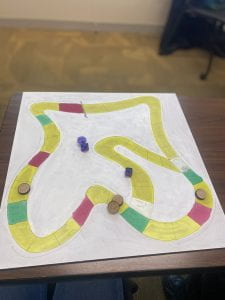
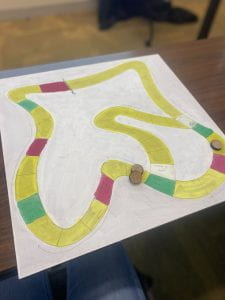
——————————————————————————————————————————————————————————————————-
Artist Statement
The idea behind this game was to go for the unfair social classes found in American society today. Social mobility is not as lenient as how the American Dream has made it out to be. The Upper class have the choice to slack off but still go through life without a lot of worry since they are provided certain privileges and opportunities that allows them to grow and benefit. Meanwhile, the lower class are at a disadvantage and requires luck to get such opportunities. Even then, they are in a different situation where their environment are also against them. The intention is for the lower class to lose around 90-95% of the time unless the players are VERY lucky. Meanwhile, the upper class doesn’t have to worry as much about going into debt since they are given a lot of chances and opportunities. After the first 2 playtests, I found out that the lower class are more likely to go negative school points by the time that they get to college. As a result, I implemented the point requirements for college. As a result, the lower classes are less likely to get the opportunity to obtain the higher-paying jobs. The university-not-required jobs are paying just enough for the player to get by, similar to that of real life struggles of those in the lower class. In the most recent in-class playthrough, the upper class player disregarded the written goal and tried to go into debt as soon as possible, however, they were able to get through the whole game and finished 2nd. I liked this result as it shows how the upper class are able to complete the goal of the game even if they are trying become their own enemies.
This idea is inspired from the game of life and the type of messages behind art games. Since art games are meant to call attention to topics that typical games do not emphasize about society, this game calls out an unfair nature of the class system. Rather than appropriating The Game of Life, I decided rebranded it with additional mechanics with the addition of the monetary value of jobs and money. Since the only similarities would be the feel of the map, it was best to rebrand the game under a different name instead of declaring it as a DLC. I also wanted a playable game like the Uncle Roy game that we’ve seen in class as opposed to an art piece similar to Mario Clouds.

